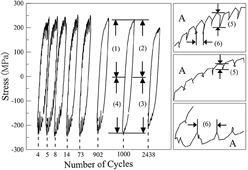Published online by Cambridge University Press: 11 March 2016

The effect of strain range on dynamic strain aging (DSA) is discussed based on the low cycle fatigue tests for different strain ranges conducted for 316L stainless steel at strain rate of 1 × 10−3 s−1. The variations of stress drop and hardening ratio are both compared for different strain ranges. The variations of stress drop are attributed to the dependence of vacancy concentration on strain range. The hardening ratio is higher at 600 °C than those at 20 °C and secondary hardening behavior occurs for larger strain range. The dependence of DSA on the number of cycles and the wave type for different stages are analyzed. Obvious DSA is observed in first few cycles, followed by weakening serrated yielding. However, the serrated yielding occurs again before fatigue failure. The difference of serrated yielding can be explained by the types of atom atmospheres at different cycles. A serrated wave is observed for smaller strain ranges, however, A, B, A + B, C, and B + C serrated waves can be found at different cycles for larger strain range. Finally, the crack nucleation and propagation on fracture surfaces are characterized by scanning electron microscope (SEM).